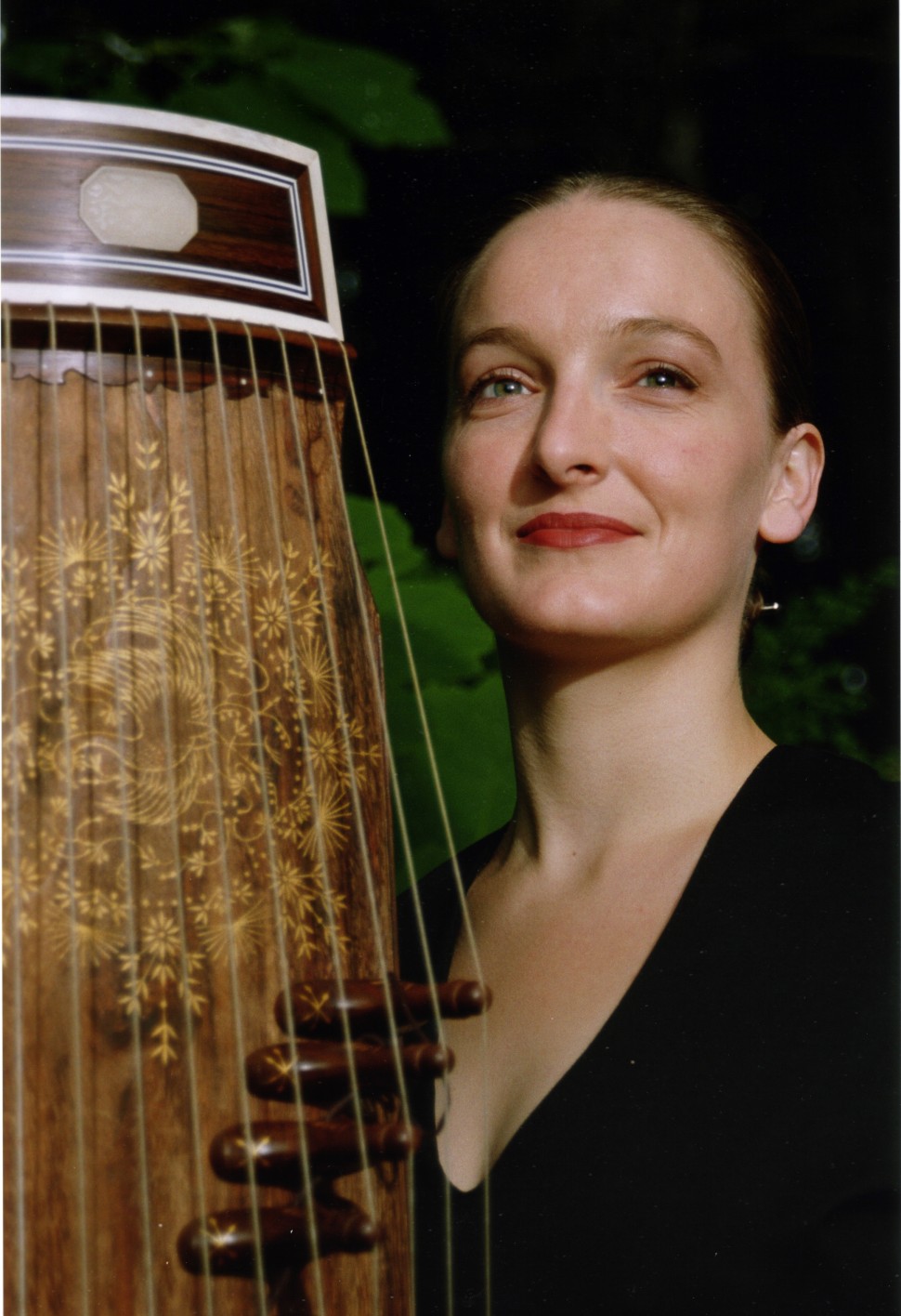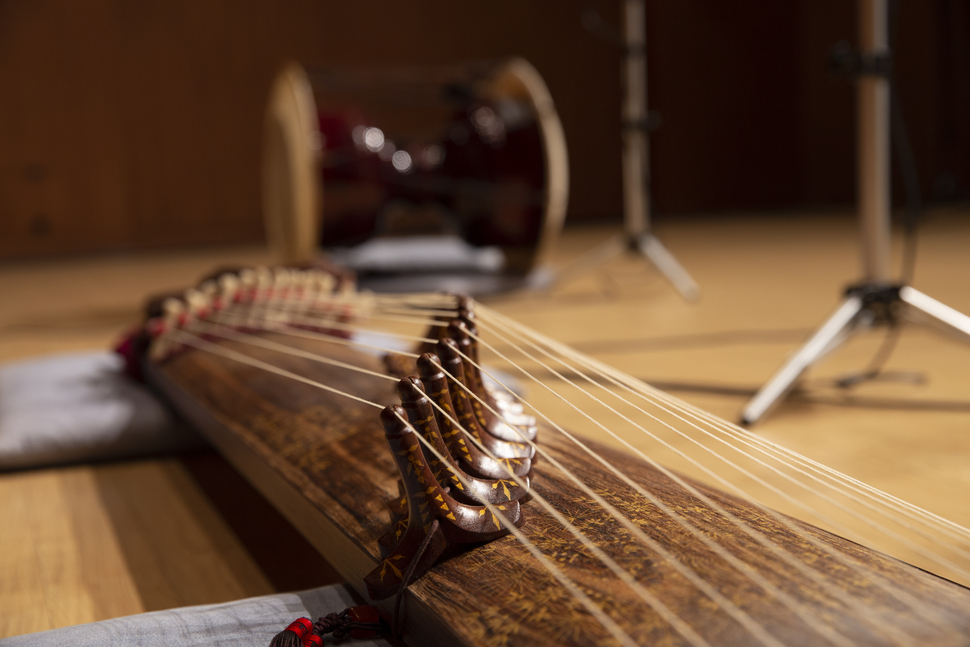[Oct] Alaska-raised Jocelyn Clark, the ‘blue-eyed’ evangelist of gayageum
Date Oct 21, 2022
 Jocelyn Clark, a gayageum player from the U.S. (Courtesy of Shelly Lightburn)
Jocelyn Clark, a gayageum player from the U.S. (Courtesy of Shelly Lightburn)
The first time Jocelyn Clark heard someone play a gayageum, a Korean 12-string zither, she didn’t get the appeal.
“I didn’t understand the sound. It was very dark and muffled,” said the Alaska-raised American. “I just didn’t understand what was going on.”
Its long rhythm patterns, with accents in unexpected places, were hard to appreciate for Clark, who was 18 or 19 at the time, and had just returned from a year abroad in Japan where she’d been studying the koto, a similar-looking string instrument made from a long board.
“I thought, ‘Oh yeah, good thing I picked the brighter, more resonant instrument, the koto,’” she recalled.
But as fate would have it, Clark received a scholarship from the National Gugak Center the following year to come to Korea and learn gugak, traditional Korean music.
“I arrived a few months before former President Kim Young-sam’s election. I bought a gayageum, got assigned a teacher and started playing until my blood blisters were popping on the sound board, but I still didn’t understand what the gayageum was all about. I didn’t love it at first,” she admitted.
That was 30 years ago, in 1992, and she’s since learned enough about the instrument to gain the Korean moniker, “the blue-eyed gayageum evangelist” (though, she points out, her eyes are not blue). These days, she teaches East Asian Studies at Pai Chai University in Daejeon and plays the gayageum at concerts before thousands of appreciative – mostly Korean – listeners.
But it wasn’t an easy journey, especially at first.
“The aesthetics and the way to appreciate Korean music is completely different than Western music or even Chinese or Japanese music, which only start to overlap a little in their court repertoires. I just couldn’t understand what made Korean folk music beautiful. It’s not what makes the music that I already knew beautiful,” she said. “I had a year to sit there and figure out why I couldn’t understand its flavor and how I could adjust my musical pallet – it was obviously my problem, not the gayageum’s. After a year of listening and playing, then I really fell in love with the gayageum and its music, but I feel like it really took that effort.”
 Gayageum (Courtesy of gettyimagesbank)
Gayageum (Courtesy of gettyimagesbank)
When she started off, Clark was interested in comparing the Korean gayageum to the Japanese koto and the Chinese zheng. The three instruments bear similarities and share origins, but have diverged in various ways over the centuries, not just in form but even more so in how they’re played and the associated musical traditions.
According to Clark, the synthetic “tetron”-stringed koto and metal-stringed zheng sound more like a harp, harmony and “flowing water” arpeggios and glissandi. The rhythms are closer to Western rhythms in 2/4 or 4/4 time.
But gayageum players pluck the typically silk strings one at a time, dampening each ringing string as they move onto the next pluck. And the rhythms are in three, or more complex polyrhythms, making it hard to follow a beat without knowing something about the pattern. Even though gayageum is often accompanied by a drum, the unfamiliar rhythmic cycles are at first hard to understand. Depending on the rhythm pattern, or jangdan (literally “long and short”), the accompanist may emphasize the first and ninth beats, unlike Western music with its recurring “1” every four beats. While the instrument lacks the ringing harmony of its Asian cousins, it offers a unique, direct voice that is close to the range of a human voice, and like a singer, “sings” one ornamented note at a time to complex rhythms. That is what Clark finally came to appreciate during her scholarship.
Today, Clark is uniquely positioned to talk about the differences between the three bridged zithers of East Asia, having been a student of each – as well as founding the contemporary music ensemble IIIZ+ (“Three Z Plus”) in 2001, which brings together players of the gayageum, koto and zheng, “plus” a Korean percussionist. She also knows quite a lot about the shared origins of the instruments and how they diverged.
The gayageum traces its origins to the latter days of Gaya, a confederacy that lasted almost 500 years from 42 to 532 in the southeastern region of the Korean Peninsula before being annexed by Silla.
According to the Samguk Sagi, or “History of the Three Kingdoms,” the gayageum was invented during the reign of Gaya King Gasil and was modeled on a Chinese zheng. He commissioned a musician named Ureuk to compose 12 songs that could be played on the instrument. But amid the decline of Gaya, Ureuk fled to neighboring Silla where he continued his career as a renowned musician.
During Joseon (1392-1910), the gayageum was originally used in music for the court and Confucianist literati. But sometime in the late 19th century, the advent of sanjo, a new type of folk music, led to a new form of the instrument and the music associated with it.
Sanjo, or heotteun garak in pure Korean, is usually translated as “scattered melodies.” It is a type of duet performance, with a solo instrument such as a gayageum accompanied by a drummer on the hourglass-shaped janggu or sometimes the barrel-shaped buk. It’s a music not of the courts but of the lower classes, originating from shamanistic rituals as well as pansori narrative singing.
The sanjo gayageum, as Clark calls it, is smaller than the “court” gayageum, which is also called the beopgeum (literally “Dharma zither”) or pungnyu (elegant) gayageum. The sanjo gayageum’s strings are closer together, enabling more virtuosic playing.
Meanwhile, the zheng, on which the gayageum was said to have been modeled, also went through vast changes over the centuries. During the 1644-1912 Qing Dynasty, it became an instrument known mainly for metal strings, but the zheng known today is a product of China’s Cultural Revolution from 1966 to 1976, during which time it went from 16 to 21 strings.
Korea’s gayageum also saw an increase in strings, with recent variations coming in 15, 17, 18, 21 or even 25 strings. “But after 18 strings, it’s a totally different instrument,” Clark said. “It moves from being pentatonic to being diatonic – closer to the tuning they use in North Korea. It’s really hard to play sanjo on the big diatonic instruments with their nylon strings – they bend differently and the octaves become quite far apart.”
Another distinction she points to is the symbolic imagery of the instruments. The Chinese and Japanese zithers are steeped in dragon imagery, while the Korean version is focused more on birds. The gayageum’s bridges are called anjok (wild goose feet), and its bottom end is likened to the tail feathers of a phoenix. There’s also the image of a crane at the top of her instrument, and Clark says gayageum players should have their hands in the shape of a crane’s wing in flight.
She also points out cosmological imagery in the shape of the gayageum, which is rounded on top like the heavens and flat on the bottom like the earth, with the player in the middle connecting heaven and earth. As well, the 12 strings represent the 12 months.
“While the instruments are all based on each other and have the same origin, the music played on each of them is all very different,” Clark said. “So a koto player can play the zheng like a koto, the zheng player can play a gayageum like a zheng, it doesn’t really matter. The construction of the instrument is not that different or interesting. They are all boards with strings stretched over movable bridges. It’s really what’s inside the player that the magic resides. The player is the vessel of culture and its music. The player transmits Korea’s unique beauty to the world. The instrument is only a beautiful refined tool.”
*The video clip below is provided by the National Gugak Center.
**If you have any questions about this article, feel free to contact us at kocis@korea.kr.**

The Ministry of Culture, Sports and Tourism's "Korea Here & Now" work can be used under the condition of "Public Nuri Type 1 (Source Indication)."




